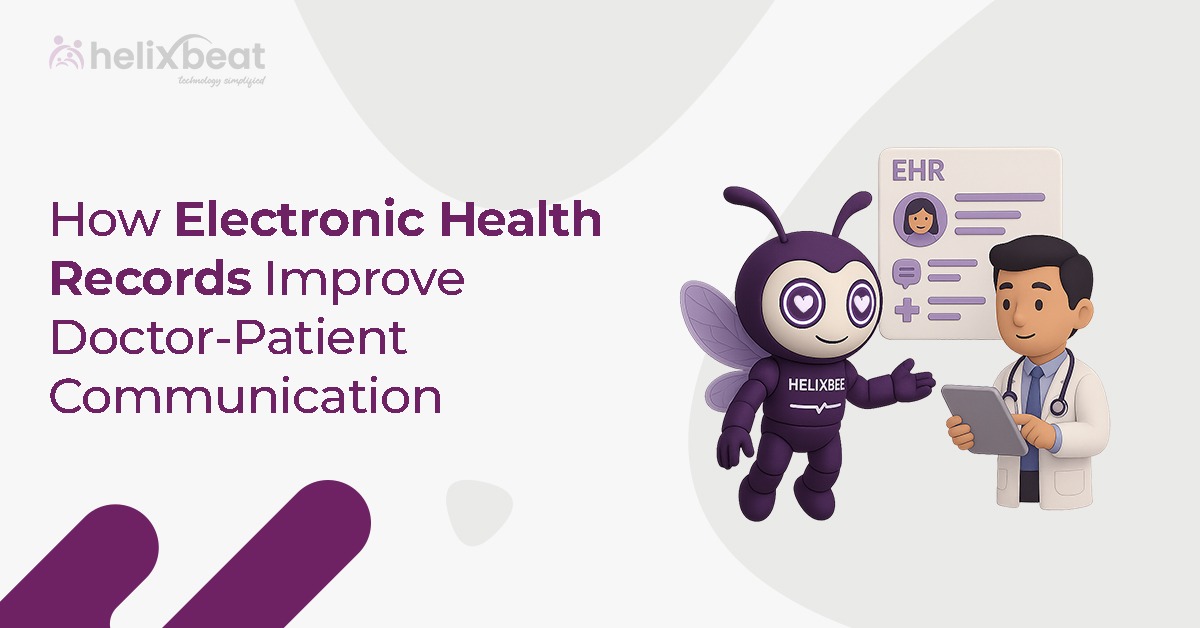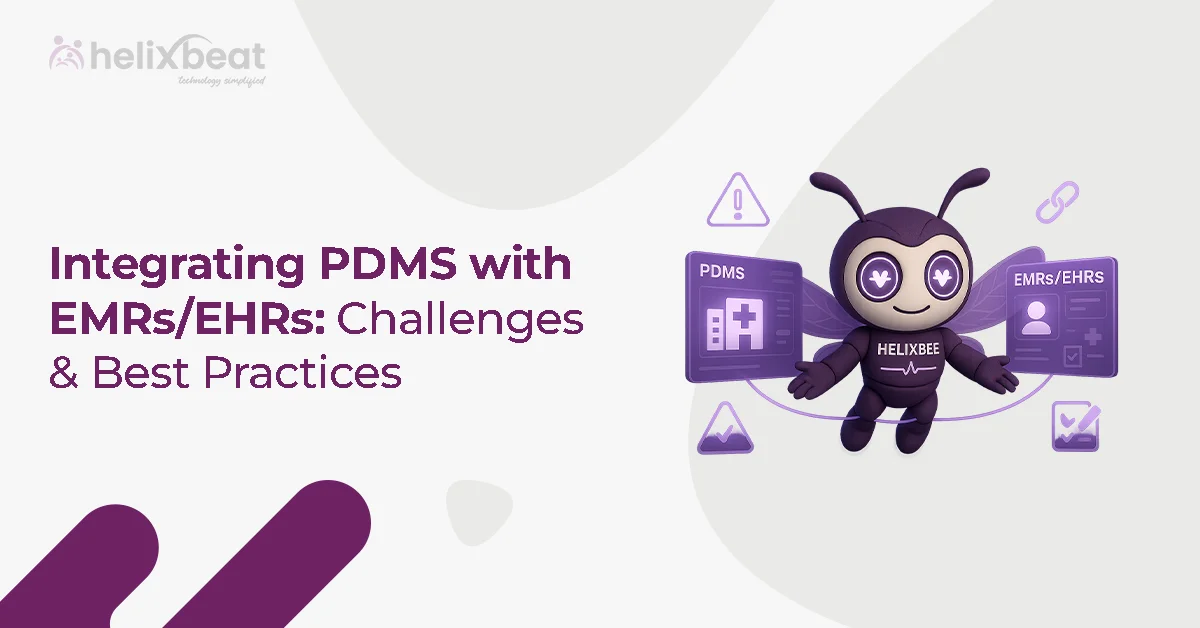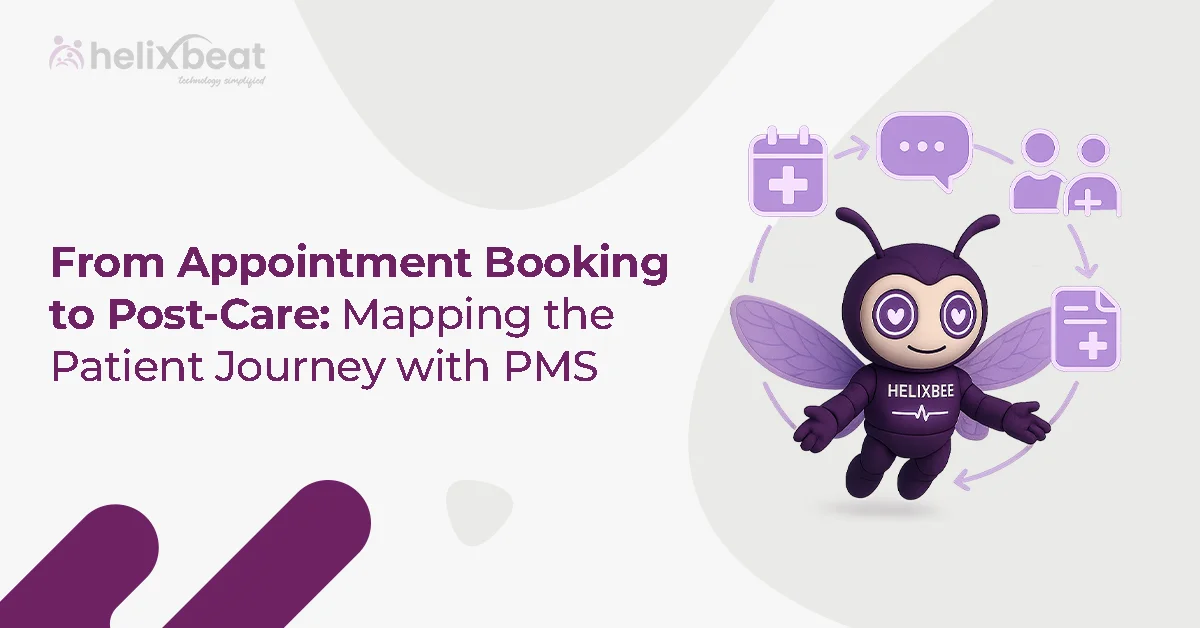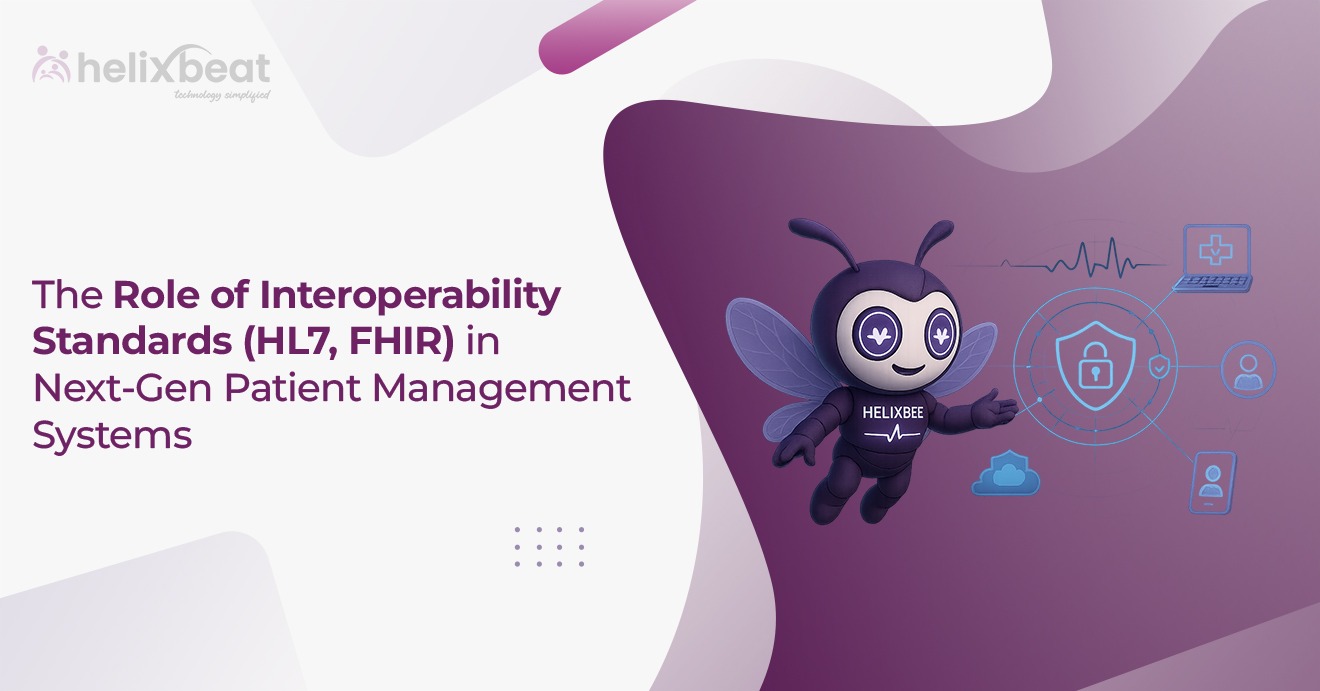Electronic health records (EHR) have emerged as a fundamental element of contemporary healthcare. By improving communication between doctors and patients, EHR systems pave the way for more efficient care delivery, ensuring information is exchanged quickly and accurately. These systems allow healthcare providers to access complete patient data at the moment’s notice, leading to better informed decisions and enhanced patient outcomes.
By increasing diagnostic accuracy and bridging communication gaps, electronic health records strengthen the doctor-patient relationship and boost the overall efficiency of healthcare services. In this blog, we explore how EHRs are transforming communication between doctors and patients and elevating the quality of care provided.

Table of Contents
What Are Electronic Health Records (EHR)?
Electronic Health Records (EHR) are digital versions of a patient’s paper chart, containing comprehensive data on a patient’s health history, including diagnoses, medications, lab results, immunization dates, treatment plans, and more. EHR systems provide a real-time, patient-centered record that is accessible across different healthcare settings, improving the accuracy, efficiency, and coordination of patient care.
Unlike traditional paper records, EHR systems allow healthcare providers to instantly access and update patient information, enhancing the quality and speed of care. The goal of EHR systems is to enhance patient care, streamline communication among healthcare providers, and maintain a comprehensive and accurate record of a patient’s healthcare journey.
Key characteristics of EHRs include:
- Real-Time Data Access: Health information is updated and available in real time, ensuring all providers have access to the latest patient data.
- Interoperability: EHR systems allow seamless sharing of patient data across different healthcare organizations, ensuring better coordination of care.
- Centralized Storage: EHR systems store patient information in one secure digital format, reducing the risk of lost or misplaced records.
Patient Testimonials or Case Studies:
Here’s a brief example of how EHRs have positively impacted patient care:
“Since our clinic adopted electronic health records, my doctor has been able to access all my medical history with just a few clicks. I no longer need to carry around paper records, and I’ve received much more timely care. The communication between my doctors has also improved. It feels great to know my healthcare team is on the same page! – Nicole M., Patient.
This testimonial highlights how EHR systems facilitate more efficient and timely care, thereby improving the overall experience for both patients and healthcare providers.
How Electronic Health Records Improve Communication
Electronic Health Records (EHR) improve communication between doctors, patients, and other healthcare providers in several keyways:
1. Instant Access to Patient Information
- EHR systems provide healthcare providers with real-time access to comprehensive patient data.
- This allows doctors to make accurate, timely decisions, reducing the risk of errors, and ensuring that patients receive the right treatment at the right time.
- Gone are the days of waiting for paper records or dealing with incomplete or outdated information.
- Example: With PULSE by HelixBeat, healthcare providers can instantly access a patient’s full medical history, enabling faster decision-making and improved care delivery.
2. Improved Doctor-Patient Communication
- EHRs enable doctors to provide more personalized and tailored care by offering a complete view of a patient’s medical history, treatment plans, preferences, and past treatments.
- This promotes more transparent and meaningful conversations between doctors and patients, as both parties are more informed.
- By having detailed insights into patient data, doctors can discuss treatment options, answer questions, and engage patients in their own care more effectively.
3. Timely Notifications and Alerts
- EHR systems help ensure both patients and healthcare providers stay on top of appointments, medication schedules, and follow-up care.
- Automated reminders sent via email, SMS, or push notifications ensure that patients don’t miss critical visits or medication refills.
- This also reduces administrative burden and improves the efficiency of the care process.
- For example, PULSE by HelixBeat can automatically notify both the patient and the healthcare provider about upcoming appointments or necessary follow-ups, ensuring better patient compliance and satisfaction.
4. Reducing Errors and Miscommunication
- One of the biggest advantages of EHR systems is the reduction of errors due to illegible handwriting or misplaced paper records.
- By digitizing health information, EHRs ensure that the information is clear, accurate, and accessible to all authorized users, reducing the chances of miscommunication or errors in patient care.
- Clear and accurate documentation helps doctors and nurses provide the best possible care, preventing misunderstandings between medical professionals and ensuring patients receive the treatment they need.
Want to see how electronic health records can enhance your practice’s communication and patient outcomes?
Request a demo of HelixBeat’s EHR solution today.
Benefits of Electronic Health Records in Enhancing Patient Care
Electronic Health Records offer a wide range of benefits that directly impact patient care. Here are some of the most important advantages:
- Enhanced Care Coordination
- EHRs facilitate the sharing of information among healthcare providers, resulting in more coordinated and comprehensive care.
- This is especially beneficial for patients with complex, chronic conditions who see multiple specialists.
- Improved Patient Safety
- With EHRs, the risk of medication errors is minimized as the system flags potential drug interactions or allergies.
- Automated checks help reduce the likelihood of prescribing errors and improve patient safety.
- Better Tracking of Health Metrics
- EHRs allow healthcare providers to monitor a patient’s health trends over time, from lab results to vital signs.
- This makes it easier to track the effectiveness of treatments and adjust care plans accordingly.
- Faster Diagnosis and Treatment
- With instant access to patient records and test results, doctors can diagnose conditions more quickly, resulting in faster treatment and improved health outcomes.
Key Features of Electronic Patient Record Systems
When selecting an electronic patient record system, it’s important to ensure that it includes essential features to improve communication and care delivery. Here are key features to look for:
- Real-time Data Access
- Patient Portal Access
- Integrated Medical Alerts and Reminders
- Data Analytics and Reporting Tools
- Interoperability
Importance of Electronic Health Record Management
Effective electronic health record management is vital for ensuring that patient data remains secure, accessible, and up to date. Proper management ensures that:
1. Data Security and Compliance
EHR systems must comply with regulations like the HIPAA (Health Insurance Portability and Accountability Act) to ensure patient data is secure and protected from unauthorized access.
2. Efficient Workflow and Record Keeping
EHRs reduce the reliance on paper records, streamlining workflows and reducing the time spent on administrative tasks. This results in better resource utilization and more time for patient care.
3. Improved Data Accuracy
By automating data entry and reducing manual processes, EHR systems minimize the chances of errors and inconsistencies in patient records, improving the quality of patient care.
How EHRs Facilitate Communication with Other Healthcare Providers
One of the most significant advantages of electronic health records is their ability to facilitate communication with other healthcare providers. Here’s how:
1. Interoperability
EHR systems enable seamless data exchange between various healthcare organizations, including hospitals, clinics, and specialty practices. This enables better coordination of care, particularly for patients with chronic conditions that require the services of multiple providers.
2. Real-Time Information Sharing
EHR systems enable healthcare providers to instantly access a patient’s comprehensive medical history, test results, and treatment plans, ensuring that all parties involved in the care process are informed and aligned.
3. Referral Management
EHRs streamline the referral process by enabling healthcare providers to share patient information quickly and securely, reducing wait times and improving the speed of care delivery.
Challenges and Solutions in Electronic Health Record Implementation
| Challenges | Solutions |
| Data Privacy Concerns | Ensure the EHR system is HIPAA compliant and integrates robust encryption and access controls to safeguard patient data. |
| Integration with Existing Systems | Choose an EHR integration system that integrates seamlessly with other healthcare software such as EHR, PMS, and lab systems |
| User Adoption | Provide comprehensive training and support to healthcare staff to ensure the system is user-friendly and easy to adopt. |
| Data Accuracy and Consistency | Regular data audits and cleaning should be conducted to ensure the accuracy and consistency of patient records. |
| Cost of Implementation | Consider the long-term cost savings of EHR implementation, such as reduced administrative costs and improved patient care. |
| System Downtime and Technical Issues | Ensure the EHR system has reliable support, regular maintenance, and a backup plan in place to prevent disruptions. |
Final Insights
Electronic Health Records (EHRs) play a crucial role in improving communication between doctors and patients, enhancing patient care, and fostering better coordination across healthcare providers. By centralizing patient information, automating communication, and ensuring data accuracy, EHR systems streamline care delivery, reduce errors, and empower both healthcare providers and patients. With the right EHR system, healthcare organizations can improve patient outcomes, enhance patient satisfaction, and create a more efficient and effective healthcare environment.
Request a Demo of HelixBeat’s EHR System
FAQs
- What are Electronic Health Records (EHRs)?
EHRs are digital versions of patient paper charts. They contain comprehensive information about a patient’s health history, diagnoses, medications, treatment plans, and more, all stored securely and accessible across various healthcare settings.
- How do EHRs improve communication in healthcare?
EHRs improve communication by providing real-time, accurate, and complete patient data, enabling healthcare providers to make better decisions, communicate more efficiently with patients, and coordinate care across different providers.
- What is the purpose of Electronic Health Records in healthcare?
The purpose of EHRs is to streamline patient data management, improve care coordination, ensure better patient outcomes, reduce medical errors, and enhance communication between healthcare providers and patients.
- How do EHRs improve patient care?
EHRs enhance patient care by ensuring accurate, up-to-date information is readily available, reducing medication errors, improving decision-making, and enabling better care coordination across different healthcare teams.
- What is one advantage of using an EHR for communicating with other healthcare providers?
One key advantage of using EHRs is the ability to share patient information in real time between different healthcare providers, ensuring continuous and coordinated care for patients across various treatment settings.
- How do Electronic Health Records (EHR) benefit doctors and healthcare providers?
EHRs help doctors by providing immediate access to patient histories, reducing paperwork, improving diagnosis accuracy, increasing efficiency, and enabling better communication with patients and other healthcare providers.
- How do Electronic Health Records improve patient engagement?
EHRs improve patient engagement by giving patients access to their health records, enabling them to review their health status, ask questions, and engage more actively in their care plans through patient portals and regular communication.
- How does PULSE by HelixBeat enhance EHR capabilities?
PULSE by HelixBeat offers seamless integration with existing systems, real-time data access, secure communication channels, and patient engagement tools, enabling more efficient use of EHRs to improve patient care and outcomes.
- What are the key features of an Electronic Patient Record System?
Key features include centralized data storage, real-time updates, secure data sharing, appointment scheduling, automated reminders, patient portals, and data analytics to improve care coordination and decision-making.
- How does EHR implementation affect healthcare costs?
While EHR implementation can have upfront costs, it leads to long-term savings by improving operational efficiency, reducing errors, enhancing patient care, and preventing unnecessary hospital readmissions.
- What are the challenges of implementing EHR systems?
Challenges include data privacy concerns, system integration issues, user adoption hurdles, high initial costs, and the need for training healthcare staff to effectively use the system.
- How can HelixBeat assist with EHR development and implementation?
HelixBeat specializes in developing custom EHR systems that cater to the specific needs of healthcare providers, ensuring seamless integration, easy adoption, data security, and improved patient engagement through the PULSE platform.














